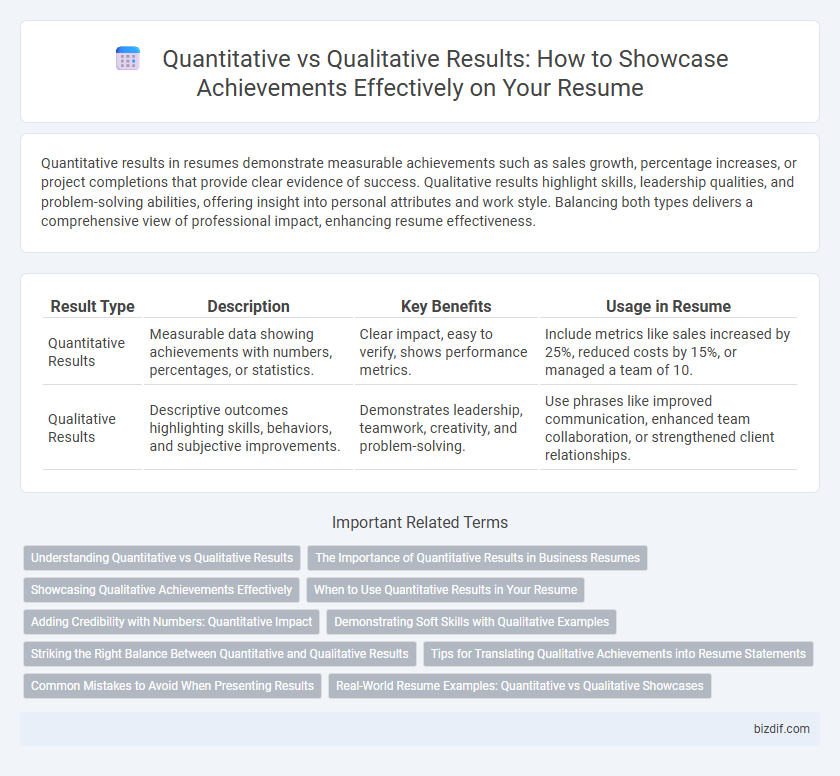Quantitative results in resumes demonstrate measurable achievements such as sales growth, percentage increases, or project completions that provide clear evidence of success. Qualitative results highlight skills, leadership qualities, and problem-solving abilities, offering insight into personal attributes and work style. Balancing both types delivers a comprehensive view of professional impact, enhancing resume effectiveness.
Table of Comparison
| Result Type | Description | Key Benefits | Usage in Resume |
|---|---|---|---|
| Quantitative Results | Measurable data showing achievements with numbers, percentages, or statistics. | Clear impact, easy to verify, shows performance metrics. | Include metrics like sales increased by 25%, reduced costs by 15%, or managed a team of 10. |
| Qualitative Results | Descriptive outcomes highlighting skills, behaviors, and subjective improvements. | Demonstrates leadership, teamwork, creativity, and problem-solving. | Use phrases like improved communication, enhanced team collaboration, or strengthened client relationships. |
Understanding Quantitative vs Qualitative Results
Understanding quantitative results in resume writing involves showcasing measurable achievements such as sales increases, productivity improvements, or cost savings, which provide clear evidence of impact. Qualitative results emphasize skills, leadership qualities, and problem-solving abilities that highlight personal strengths and workplace behaviors. Balancing both types enhances a resume by combining objective data with contextual insights, making the candidate's value more compelling to employers.
The Importance of Quantitative Results in Business Resumes
Quantitative results are crucial in business resumes as they provide concrete evidence of achievements through measurable data such as percentage increases in sales, cost reductions, or revenue growth. These figures demonstrate an applicant's impact clearly and enhance credibility by converting abstract skills into tangible outcomes. Employers prioritize candidates who showcase quantifiable success, facilitating easier assessment of potential contributions to business goals.
Showcasing Qualitative Achievements Effectively
Highlighting qualitative achievements in a resume involves demonstrating impact through storytelling, leadership, and problem-solving examples that resonate with employers' values and company culture. Emphasize contributions such as team mentorship, process improvements, and client relationship building by illustrating specific scenarios and outcomes. Use action-oriented language and quantify where possible to provide context, ensuring qualitative results complement quantitative data to present a comprehensive professional profile.
When to Use Quantitative Results in Your Resume
Quantitative results on a resume are most effective when showcasing measurable achievements such as sales growth, cost reduction, or productivity improvements, providing clear evidence of impact. Use specific numbers, percentages, or timeframes to highlight accomplishments that demonstrate value to potential employers. Emphasizing quantitative data is especially important for roles with performance metrics, allowing recruiters to quickly assess your contribution and success.
Adding Credibility with Numbers: Quantitative Impact
Quantitative results enhance resume credibility by providing clear, measurable evidence of achievements, such as increasing sales by 30% or reducing costs by $50,000 annually. Numbers offer concrete proof that demonstrate the candidate's impact, making accomplishments more compelling to employers. Incorporating specific metrics transforms vague claims into powerful statements that validate skills and effectiveness.
Demonstrating Soft Skills with Qualitative Examples
Qualitative results in resume writing effectively demonstrate soft skills by highlighting specific examples of teamwork, communication, and leadership through detailed narratives. Unlike quantitative results that rely on numbers and metrics, qualitative examples showcase problem-solving abilities, adaptability, and emotional intelligence in real workplace scenarios. Incorporating story-driven achievements helps recruiters understand the candidate's interpersonal strengths and cultural fit beyond numerical performance indicators.
Striking the Right Balance Between Quantitative and Qualitative Results
Striking the right balance between quantitative and qualitative results enhances resume impact by showcasing measurable achievements alongside meaningful insights. Quantitative metrics such as sales growth or project completion rates demonstrate clear performance, while qualitative descriptions of teamwork, leadership, and problem-solving highlight interpersonal skills and adaptability. Combining both types of evidence provides employers a comprehensive view of a candidate's capabilities and potential contributions.
Tips for Translating Qualitative Achievements into Resume Statements
Translate qualitative achievements into quantifiable resume statements by identifying measurable impacts such as increased customer satisfaction scores or improved team collaboration efficiency. Use specific examples like "enhanced client relationships leading to a 15% boost in repeat business" to provide concrete evidence of success. Highlight soft skills with outcomes that can be numerically or contextually demonstrated to balance the narrative between qualitative and quantitative results.
Common Mistakes to Avoid When Presenting Results
Presenting quantitative results without context often confuses recruiters, while relying solely on qualitative results can seem vague and unsubstantiated. Avoid common mistakes such as failing to link numerical achievements to business impact or neglecting to illustrate personal contributions through descriptive examples. Balancing precise metrics like percentage increase in sales with qualitative feedback highlights both performance and leadership skills effectively.
Real-World Resume Examples: Quantitative vs Qualitative Showcases
Quantitative results in resumes highlight measurable achievements such as "increased sales by 30%" or "reduced costs by $15,000," providing clear evidence of impact. Qualitative results emphasize skills, leadership, and personal attributes, like "improved team collaboration" or "enhanced client satisfaction," showcasing value beyond numbers. Real-world resume examples demonstrate that combining both quantitative metrics and qualitative highlights creates a compelling narrative that attracts employers and differentiates candidates effectively.
Quantitative results vs Qualitative results Infographic

 bizdif.com
bizdif.com